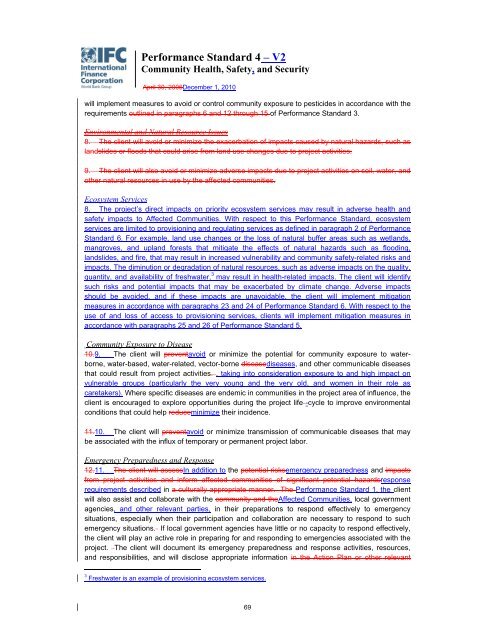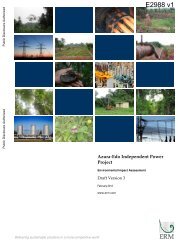Performance Standard 4 â V2 - IFC
Performance Standard 4 â V2 - IFC
Performance Standard 4 â V2 - IFC
Create successful ePaper yourself
Turn your PDF publications into a flip-book with our unique Google optimized e-Paper software.
<strong>Performance</strong> <strong>Standard</strong> 4 – <strong>V2</strong><br />
Community Health, Safety, and Security<br />
April 30, 2006December 1, 2010<br />
will implement measures to avoid or control community exposure to pesticides in accordance with the<br />
requirements outlined in paragraphs 6 and 12 through 15 of <strong>Performance</strong> <strong>Standard</strong> 3.<br />
Environmental and Natural Resource Issues<br />
8. The client will avoid or minimize the exacerbation of impacts caused by natural hazards, such as<br />
landslides or floods that could arise from land use changes due to project activities.<br />
9. The client will also avoid or minimize adverse impacts due to project activities on soil, water, and<br />
other natural resources in use by the affected communities.<br />
Ecosystem Services<br />
8. The project’s direct impacts on priority ecosystem services may result in adverse health and<br />
safety impacts to Affected Communities. With respect to this <strong>Performance</strong> <strong>Standard</strong>, ecosystem<br />
services are limited to provisioning and regulating services as defined in paragraph 2 of <strong>Performance</strong><br />
<strong>Standard</strong> 6. For example, land use changes or the loss of natural buffer areas such as wetlands,<br />
mangroves, and upland forests that mitigate the effects of natural hazards such as flooding,<br />
landslides, and fire, that may result in increased vulnerability and community safety-related risks and<br />
impacts. The diminution or degradation of natural resources, such as adverse impacts on the quality,<br />
quantity, and availability of freshwater, 3 may result in health-related impacts. The client will identify<br />
such risks and potential impacts that may be exacerbated by climate change. Adverse impacts<br />
should be avoided, and if these impacts are unavoidable, the client will implement mitigation<br />
measures in accordance with paragraphs 23 and 24 of <strong>Performance</strong> <strong>Standard</strong> 6. With respect to the<br />
use of and loss of access to provisioning services, clients will implement mitigation measures in<br />
accordance with paragraphs 25 and 26 of <strong>Performance</strong> <strong>Standard</strong> 5.<br />
Community Exposure to Disease<br />
10.9. The client will preventavoid or minimize the potential for community exposure to waterborne,<br />
water-based, water-related, vector-borne diseasediseases, and other communicable diseases<br />
that could result from project activities. , taking into consideration exposure to and high impact on<br />
vulnerable groups (particularly the very young and the very old, and women in their role as<br />
caretakers). Where specific diseases are endemic in communities in the project area of influence, the<br />
client is encouraged to explore opportunities during the project life -cycle to improve environmental<br />
conditions that could help reduceminimize their incidence.<br />
11.10. The client will preventavoid or minimize transmission of communicable diseases that may<br />
be associated with the influx of temporary or permanent project labor.<br />
Emergency Preparedness and Response<br />
12.11. The client will assessIn addition to the potential risksemergency preparedness and impacts<br />
from project activities and inform affected communities of significant potential hazardsresponse<br />
requirements described in a culturally appropriate manner. The <strong>Performance</strong> <strong>Standard</strong> 1, the client<br />
will also assist and collaborate with the community and theAffected Communities, local government<br />
agencies, and other relevant parties, in their preparations to respond effectively to emergency<br />
situations, especially when their participation and collaboration are necessary to respond to such<br />
emergency situations. If local government agencies have little or no capacity to respond effectively,<br />
the client will play an active role in preparing for and responding to emergencies associated with the<br />
project. The client will document its emergency preparedness and response activities, resources,<br />
and responsibilities, and will disclose appropriate information in the Action Plan or other relevant<br />
3<br />
Freshwater is an example of provisioning ecosystem services.<br />
69
















